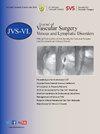利用机器学习预测下腔静脉过滤器并发症。
IF 2.8
2区 医学
Q2 PERIPHERAL VASCULAR DISEASE
Journal of vascular surgery. Venous and lymphatic disorders
Pub Date : 2024-07-29
DOI:10.1016/j.jvsv.2024.101943
引用次数: 0
摘要
目的:下腔静脉(IVC)滤器置入术与重要的长期并发症有关。过滤器相关并发症的预测模型可能有助于指导临床决策,但仍然有限。我们开发了机器学习(ML)算法,利用术前数据预测 IVC 过滤器 1 年并发症:我们利用血管质量倡议(Vascular Quality Initiative,VQI)数据库确定了 2013-2024 年间接受 IVC 过滤器置入术的患者。我们从放置过滤器的住院索引中确定了 77 项术前人口学/临床特征。主要结果是 1 年滤器相关并发症(滤器血栓、移位、成角、断裂、栓塞或碎裂、静脉穿孔、新的腔静脉或髂静脉血栓、新的肺栓塞、通路部位血栓或取栓失败的复合情况)。数据分为训练集(70%)和测试集(30%)。使用术前特征训练了六个多重L模型,并进行了 10 次交叉验证(极端梯度提升 [XGBoost]、随机森林、奈夫贝叶斯分类器、支持向量机、人工神经网络和逻辑回归)。模型的主要评估指标是接收者工作特征曲线下面积(AUROC)。使用校准图和 Brier 分数评估模型的稳健性。根据年龄、性别、种族、民族、乡村、地区贫困指数中位数、滤器的计划持续时间、滤器的着床部位以及是否曾放置过 IVC 滤器,对不同亚组的性能进行评估:共有 14476 名患者接受了 IVC 过滤器置入术,其中 584 人(4.0%)在术后 1 年出现了与过滤器相关的并发症。出现主要并发症的患者年龄更小(59.3 [SD 16.7] 岁 vs. 63.8 [SD 16.0] 岁,P < 0.001),更有可能存在血栓风险因素,包括血栓性疾病、既往静脉血栓栓塞症(VTE)和VTE家族史。最佳预测模型是 XGBoost,AUROC(95% CI)为 0.93(0.92-0.94)。相比之下,逻辑回归的AUROC(95% CI)为0.63(0.61-0.65)。校准图显示,预测/观测事件概率之间的一致性良好,Brier 评分为 0.07。1 年滤器相关并发症的前 10 个预测因素是:1)血栓性疾病;2)既往 VTE;3)抗磷脂抗体;4)因子 V Leiden 突变;5)VTE 家族史;6)IVC 滤器计划使用时间(临时);7)无法维持治疗性抗凝;8)恶性肿瘤;9)近期/活动性出血;10)年龄。模型的性能在所有分组中都保持稳定:我们开发的 ML 模型可以准确预测 IVC 过滤器 1 年的并发症,其表现优于逻辑回归。这些算法在指导患者选择滤器置入、咨询、围手术期管理和随访以减少滤器相关并发症和改善预后方面具有重要的潜在作用。本文章由计算机程序翻译,如有差异,请以英文原文为准。
Predicting inferior vena cava filter complications using machine learning
Objective
Inferior vena cava (IVC) filter placement is associated with important long-term complications. Predictive models for filter-related complications may help guide clinical decision-making but remain limited. We developed machine learning (ML) algorithms that predict 1-year IVC filter complications using preoperative data.
Methods
The Vascular Quality Initiative database was used to identify patients who underwent IVC filter placement between 2013 and 2024. We identified 77 preoperative demographic and clinical features from the index hospitalization when the filter was placed. The primary outcome was 1-year filter-related complications (composite of filter thrombosis, migration, angulation, fracture, and embolization or fragmentation, vein perforation, new caval or iliac vein thrombosis, new pulmonary embolism, access site thrombosis, or failed retrieval). The data were divided into training (70%) and test (30%) sets. Six ML models were trained using preoperative features with 10-fold cross-validation (Extreme Gradient Boosting, random forest, Naïve Bayes classifier, support vector machine, artificial neural network, and logistic regression). The primary model evaluation metric was area under the receiver operating characteristic curve (AUROC). Model robustness was assessed using calibration plot and Brier score. Performance was evaluated across subgroups based on age, sex, race, ethnicity, rurality, median Area Deprivation Index, planned duration of filter, landing site of filter, and presence of prior IVC filter placement.
Results
Overall, 14,476 patients underwent IVC filter placement and 584 (4.0%) experienced 1-year filter-related complications. Patients with a primary outcome were younger (59.3 ± 16.7 years vs 63.8 ± 16.0 years; P < .001) and more likely to have thrombotic risk factors including thrombophilia, prior venous thromboembolism (VTE), and family history of VTE. The best prediction model was Extreme Gradient Boosting, achieving an AUROC of 0.93 (95% confidence interval, 0.92-0.94). In comparison, logistic regression had an AUROC of 0.63 (95% confidence interval, 0.61-0.65). Calibration plot showed good agreement between predicted/observed event probabilities with a Brier score of 0.07. The top 10 predictors of 1-year filter-related complications were (1) thrombophilia, (2) prior VTE, (3) antiphospholipid antibodies, (4) factor V Leiden mutation, (5) family history of VTE, (6) planned duration of IVC filter (temporary), (7) unable to maintain therapeutic anticoagulation, (8) malignancy, (9) recent or active bleeding, and (10) age. Model performance remained robust across all subgroups.
Conclusions
We developed ML models that can accurately predict 1-year IVC filter complications, performing better than logistic regression. These algorithms have potential to guide patient selection for filter placement, counselling, perioperative management, and follow-up to mitigate filter-related complications and improve outcomes.
求助全文
通过发布文献求助,成功后即可免费获取论文全文。
去求助
来源期刊

Journal of vascular surgery. Venous and lymphatic disorders
SURGERYPERIPHERAL VASCULAR DISEASE&n-PERIPHERAL VASCULAR DISEASE
CiteScore
6.30
自引率
18.80%
发文量
328
审稿时长
71 days
期刊介绍:
Journal of Vascular Surgery: Venous and Lymphatic Disorders is one of a series of specialist journals launched by the Journal of Vascular Surgery. It aims to be the premier international Journal of medical, endovascular and surgical management of venous and lymphatic disorders. It publishes high quality clinical, research, case reports, techniques, and practice manuscripts related to all aspects of venous and lymphatic disorders, including malformations and wound care, with an emphasis on the practicing clinician. The journal seeks to provide novel and timely information to vascular surgeons, interventionalists, phlebologists, wound care specialists, and allied health professionals who treat patients presenting with vascular and lymphatic disorders. As the official publication of The Society for Vascular Surgery and the American Venous Forum, the Journal will publish, after peer review, selected papers presented at the annual meeting of these organizations and affiliated vascular societies, as well as original articles from members and non-members.
 求助内容:
求助内容: 应助结果提醒方式:
应助结果提醒方式:


